Misc Disc

Back to Home
Stall Count & Fast Count Good Stack / Bad Stack Cut To Open Space Dump-Swing Zone Defense
Stall Count & Fast Count
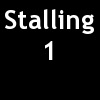
The stall count consists of announcing "stalling" and counting from one to ten loudly enough for the thrower to hear. The interval between each number in the stall count must be at least one second.
"Fast Count" is called if the marker does not initiate the stall count with the word "stalling" or if the marker counts faster than one number per second. Since this is a marking violation, there is no stoppage of play for fast count. The marker needs to subtract one from count reached and continue at the proper pace. (Ex. "Stalling,1,2,3,4" "Fast Count!" "3...4...5...6...")
If the thrower needs calls fast count more than once during the same possession, he/she may call fast count again or consider it a general defensive violation by calling "Violation!" For a violation, play stops and, if uncontested, the disc is checked back in with a fresh stall count.
Good Stack / Bad Stack
 |
This is a BAD stack. It is: |
|
 |
This is a GOOD stack. It is: |
Cutting to Open Space
|
"...look for an opportunity. Then, make a cut away from that opportunity..." This is sort of what Nabity is talking about in his comments: Here we have two cutters at the back of the stack that notice some nice open areas (opportunities) to take advantage of. |
 |
|
Instead of heading straight to those areas, the cutters want to head down field and somewhat away from those opportunities before changing direction (cutting). This is done in an effort to become more open with less effort as well as to keep your defense from poaching into other open lanes. |
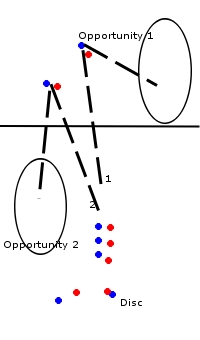 |
|
In this example, Cutter 1 might not be open enough for the thrower and should clear back into the stack if the disc isn't thrown to him/her. Cutter two might get a breakmark throw from the thrower or be the swing if the disc is dumped. |
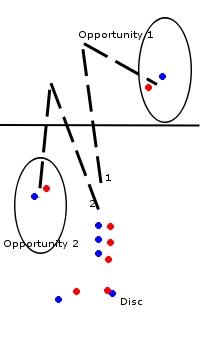 |
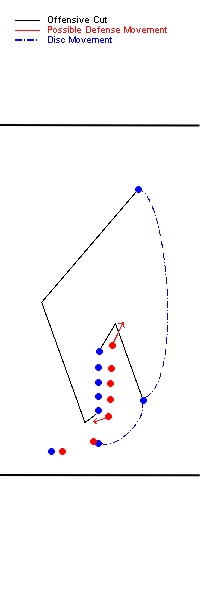 |
This is an example of the types of cuts we want to make: down field and then back in, vertically up and down the field instead of back and forth in front of the disc. It's often a good idea for the cutter at the front of the stack to cut long to clear their defender out of the way. Always remember: CLEAR back to the stack after making a cut. The stack will move down field as the disc does. An animated version of this movement can be found at Skills & Drills. (Java required.) |
Dump-Swing
Dump-Swing Keep in mind that all stationary dots on this diagram may be in motion during play. This is an ideal situation. In practice, it will often look different. |
 |
Zone Defense - Cup & Wings
IT'S ALL ABOUT THE GAPS.
The primary job of the cup and wings is to contest downfield throws by forming a sort-of curved wall that the handlers must throw over. This is done by plugging gaps between the fellow members of the defense.
 Fig. 1 |
The three members of the cup need maintain their general shape, with the points of the cup hustling to mark and the middle person plugging the gap between them. In a standard cup, the middle of the cup DOES NOT mark. Aside from the member of the cup that is marking, all other players must remain three meters (10 feet) away from the person with the disc. |
|
The first job of the wings is to plug the two gaps between the members of the cup. When set, the wings should generally not allow the offense to cut inside of them toward the disc. It is often helpful for wings (and the middle of the cup) to take look behind them to see if any offensive players are nearing the cup. | ||
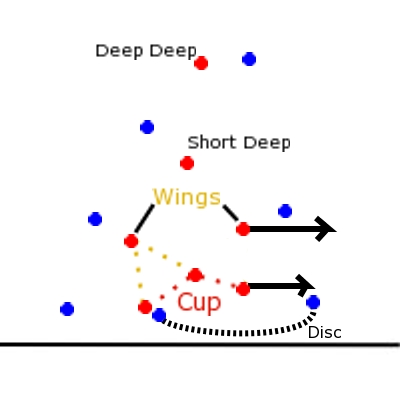 Fig. 2 |
When the disc swings to one of the side handlers, the wing has a second responsibility: cutting off the down-the-line throw. One of the easiest ways of doing this is by heading directly to the sideline. The wing should NEVER come in to mark the disc. (That is the responsibility of the points of the cup.) |
|
|
The wing should also resist the urge to follow an offensive player too far downfield. Their primary responsibility is to plug the gap between the point of the the cup and the middle of the cup. Again, it's very helpful for the wing to take glance behind them to see if any offensive players are cutting in toward the cup and handlers. |
||
 Fig. 3 |
After the disc is caught by the side handler and the possible down-the-sideline throw has been stopped, the cup and wings resume their earlier configuration with, most likely, the other point of the cup marking. |
|
To reiterate: Zone defense relies on the inconsistancies of the offense's handlers. We want to force them to make the 20 swings back and forth across the field or the risky throw over the our cup and wings. Chances are they will make a mistake and a turnover. We cannot let them have easy throws to people who have cut inside our wings. |
